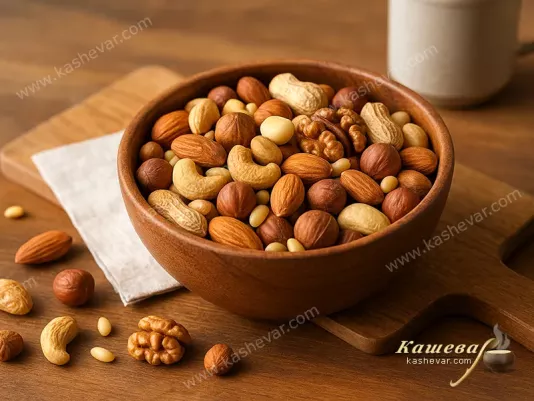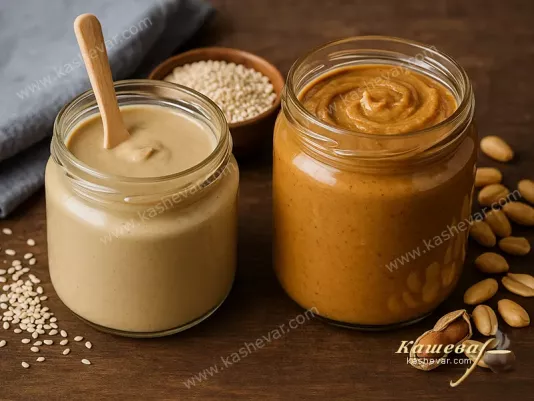Nuts and Pastes
Nuts and pastes are always present in my kitchen, as they open countless possibilities for preparing a wide variety of dishes. Nuts are not only a tasty snack but also a universal ingredient that adds texture and nutrition to salads, sauces, and desserts. They are rich in proteins, healthy fats, and vitamins, so they help balance nutrition. Nut and seed pastes I use as a base for cake creams, add to smoothies, or simply spread on bread. Their natural sweetness and intense flavor allow me to reduce the amount of sugar in baked goods and desserts, making them healthier. In my experience, nuts and pastes always come to the rescue when I need to quickly prepare something nutritious yet tasty: from energy bars to homemade sauces. I am convinced that these ingredients are a true foundation of modern cuisine, combining health with gastronomic pleasure.
Different Types of Nuts and Pastes
Nuts in Cooking
In my kitchen, nuts always hold an honorable place, as they give dishes a special character. I often use walnuts in baking: they go perfectly with honey, apples, or cinnamon, creating a rich and warm flavor. Almonds help give cakes and cookies refinement, and combined with fruits, they enhance their natural sweetness. Pistachios for me are not just decoration but a real ingredient that adds a delicate green shade and special flavor to creams and desserts. Nuts are also great in salads. I like adding roasted cashews or hazelnuts to green salads for a pleasant contrast of textures – soft vegetables and crunchy nuts create a harmonious balance. In meat dishes, nuts act as an accent: they can form the base for sauces or breading, adding depth and nutrition to the dish. From my experience, nuts are universal: they can be used in both sweet and savory recipes. They always enrich the taste, making it more complex and interesting. I always recommend buying nuts in shells or freshly shelled, as they keep freshness and aroma longer. Proper storage is also important – in airtight containers and a cool place, nuts remain tasty and nutritious much longer.
Nut Pastes
In my experience, nut pastes are a real treasure in the kitchen, as they combine rich flavor, health benefits, and versatility. I often use classic peanut butter as a spread on toast or with fruits – apples or bananas. It adds satiety and energy, especially in the morning. Almond paste is more delicate, with a subtle aroma, so I like to add it to cake creams or use it as a filling for cookies. Pistachio paste for me is the perfect ingredient for desserts: it gives them sophistication and a pleasant green shade. When I make energy bars or smoothies, nut pastes are my main helpers. They add thickness, nutrition, and make the dish more balanced. I especially enjoy combining paste with honey and seeds – it makes a natural and very healthy alternative to store-bought sweets. I also often use nut pastes as a base for sauces: peanut paste combined with soy sauce and garlic creates a spicy sauce for chicken or vegetables. I have found that the quality of the paste matters a lot. Natural products without added sugar or preservatives are much tastier and healthier. Nut pastes allow me to experiment in different directions – from classic desserts to modern healthy snacks. And thanks to them, even a simple dish reaches a new level of flavor and nutritional value.
Seed Pastes
Seed pastes became a true discovery for me, as they are no less interesting than nut ones and sometimes even surpass them in health benefits. Most often I use sesame paste tahini, which is the basis of many Middle Eastern dishes. It pairs beautifully with lemon juice and garlic, forming a sauce for vegetables or hummus. Tahini gives dishes a creamy texture and a light bitterness that I really appreciate. Sunflower seed paste, which I prepare at home from fresh seeds, turns out nutritious and slightly reminiscent of nut spreads in taste, but with a more delicate structure. I often add seed pastes to smoothies, as they increase the nutritional value of the drink and make it thicker. Combined with banana and oat milk, they create a wholesome breakfast that energizes for a long time. In baking, seed pastes also work wonderfully: a small amount adds elasticity and rich flavor to the dough. Especially tasty are cookies with pumpkin seed paste, as it has a pleasant nutty note. I like that seed pastes are suitable for people who avoid nuts due to allergies but still want to enjoy the benefits and taste of similar products. I always recommend preparing them at home from quality seeds, as this way you can control the composition and avoid unnecessary additives. For me, these pastes are a great way to diversify the diet and make it healthier and more balanced.
Nuts and Pastes in Desserts
My experience shows that nuts and pastes reveal themselves best in desserts, as they give sweet dishes a new level of flavor and texture. For example, in pastries I often use almonds or hazelnuts, which add crunch and create a special aroma. Walnuts are perfect for honey cakes and rolls, where they combine with spices and caramel. Pistachios have become my favorite ingredient in ice cream and creams, as they not only decorate but also make the taste more expressive. I add nut pastes to mousses and cake fillings. For instance, peanut paste pairs harmoniously with chocolate, while almond paste makes creams lighter and more delicate. When I want to make a dessert festive, I use pistachio paste – it adds a green tint and a light nutty aftertaste. Seed pastes also work great in sweet dishes: tahini adds depth of flavor to cookies or pies, and pumpkin seed paste makes desserts special thanks to its unusual note. For me, nuts and pastes in desserts are a way to turn even the simplest recipes into something unique. They also help control sweetness, since with their natural intensity less sugar is needed. I am convinced that these ingredients give homemade sweets a restaurant-level quality and make them truly unforgettable for family and guests.
Practical Tips for Using Nuts and Pastes
From my experience, nuts and pastes should be used carefully and thoughtfully to reveal their full potential in a dish. First, I always recommend roasting nuts before adding them to salads or desserts. This enhances their aroma and makes the taste more expressive. Second, it’s important to control the quantity: too many nuts can make a dish too heavy, so I add them moderately, keeping a balance with the main ingredients. I always stir pastes before using, as natural oils can separate and make the taste uneven. Another secret I use is combining different types of nuts and pastes in one dish. For example, in salads I mix walnuts with almonds, while in baking I add pistachios together with hazelnuts, creating interesting contrasts. I also love experimenting with pastes: peanut with honey and tahini with lemon juice – two completely different options, but both tasty and nutritious. For storage, I use glass jars with tightly sealed lids to keep nuts and pastes fresh. I always store them in a cool place, and some pastes I keep in the refrigerator. I have found that following these simple rules helps make the most of the benefits and flavor of nuts and pastes. For me, they remain universal ingredients that enrich both everyday meals and festive culinary creations.

